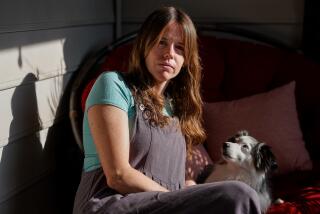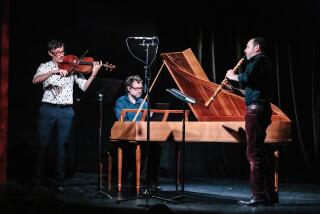Junkyard Music : Teacher Jars Youths With Symphony of Hardware
When Larry Stein takes his music appreciation program on the road, he sets out from his Newhall studio in a car loaded with pots, pans, pieces of wood, snow chains, cardboard boxes and L’eggs containers filled with sand, rice and beans.
He takes along a few of the more expected items, such as drums and tambourines--sometimes even a string quartet--but it is his ability to make music with anything and everything that delights his audiences.
And, when the children hear the music that can come out of such everyday junk, they are hooked.
A young-looking 37 despite his thick white hair, Stein is not just a modern Spike Jones who gets a thrill out of unconventional music. He is the national associate director of Young Audiences, a nationwide, nonprofit organization bringing professional musicians, dancers and actors into the nation’s schools through 38 chapter affiliates. The program reaches 5 million children a year.
Stein helps train other artists to transfer their creative zeal to schoolchildren.
Working with fellow percussionist Gregg Johnson, one of Stein’s most popular shows is “The Sound Idea.” Assuming the postures of Funky Fred and Smooth Sam, they teach rhythm by having the children shout “beans, ta-cos, to-sta-das, en-chi-la-das” as they tap. Stein shouts out “That’s the rhythm!” and then, “That’s the beat!” as the children tap.
A longtime fan of composer John Cage, Stein is producing a weeklong tribute to the composer for the Los Angeles Festival in September. One of the highlights of the week is expected to be “The Music Circus,” which will be performed in front of the Children’s Museum in downtown Los Angeles.
“It’s a chance for as many unconnected musical groups as possible to play at the same time, which represents how the world is. It’ll be a great cacophony of world music, set up like a swap meet so people can wander up and down the aisle and listen.”
Growing up in New York state, Stein started playing drums in the second grade.
“My mother found out you had to be in third grade to be in the band, and she made a big stink so they let me in. There were 30 in the band, and 12 were drummers.”
By high school, Stein and his group were winning all the local “Battle of the Bands” contests. “I was rich. I was doing five gigs a week in the Catskills.”
He entered the University of Buffalo as an aeronautical engineering major but signed up for the marching band and the school’s free music lessons. His interest in music gradually overtook his interest in engineering.
Thrill of Teaching
Stein says he had “absolutely no interest” in teaching children about music until his college percussion group needed to finance a trip to Europe and agreed to teach youngsters at a Ford Foundation-sponsored summer program.
“They promised us $1,000 each, and that was enough to get us to Europe, so we did it.”
He calls this first attempt “a total washout. I thought it would be a great idea to put the marimbas on the floor to get down there with the kids, but it wasn’t. I had drawn musical notes on Plexiglass, and I didn’t realize the edges of the Plexiglass had cut my hands until someone in the audience said, ‘Your hands are bleeding.’ That ended it right there.”
But the thrill of explaining music to children stayed with him.
He moved to the West Coast to attend California Institute of the Arts, where he worked on his master’s degree in music and specialized in East Indian tabla music and electronic computer music.
He was hired as a music teacher at Wiley Canyon Elementary School in Newhall.
“It was five mornings a week and I found it very restricting,” he said. “I left after a year and went to Castaic Elementary School, which offered the same hours, but I could do them in two days.”
“Two years later, even two days a week bothered me so I found two other artists, and we petitioned the state to split a grant three ways.” Stein then joined Young Audiences and began traveling around the state, giving workshops for musicians, dancers and actors on how to work with children. He had found his niche.
“I like to allow kids creative choice,” Stein said. He does this by playing a Mozart piece (“which means nothing to kids”) and asking them to think of a good name for it. Or he brings out his fake dial and invites the children to turn it faster or slower as he plays accordingly.
To show the importance of the cello in a string quartet, he has the cellist check his watch, announce a prior engagement and rush out of the room. The others try to carry on without him and the children can hear how the absence of the cellist affects the music.
‘It’s a Hybrid’
“It’s not teaching. It’s not performing. It’s a hybrid.”
Wandering about his small, crowded backyard studio and playing with odd inventions such as the aluminophone, his face lights up as he talks about his work.
“Kids let you be yourself. You can’t get away with anything. They have an immediate, uninhibited response.
“When it’s working, it’s unbelievable. Their eyes open, their jaws drop. With younger kids, I’m almost a clown. With older kids, the questions get better.
“The only time you have anything approaching the same response with adults is when they’re drunk. Then they love being treated like 8-year-olds and have a great time.”
More to Read
The biggest entertainment stories
Get our big stories about Hollywood, film, television, music, arts, culture and more right in your inbox as soon as they publish.
You may occasionally receive promotional content from the Los Angeles Times.










